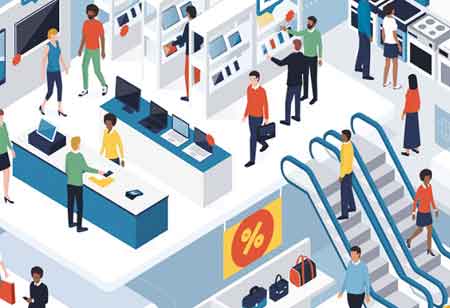Thank you for Subscribing to Construction Business Review Weekly Brief

Technology, Purpose and the Office
The last 2 years have proven to be a worldwide experiment on the workplace evolution. There has been much written on the topic of ‘future of work’ and the role the office has to play. Terms such as third space, hybrid, flexible, hot desking, work from home have all become common vocabulary.
While some organizations are still very much in beta mode or taking an experimental approach to the office, others have taken extreme approaches; by shrinking the office extensively in some cases to nonexistence. What we have learned is that work can happen anywhere and at any time. The ‘workplace’ can be anywhere – as work can happen from any place. So what is the purpose of the office? For the office to provide a meaningful and effective place of work, technology needs to play a major role along with organizational culture and behavior.
As thousands of organizations embark on coaxing teams back to the office, the employee experience is paramount - with technology playing a fundamental role in enhancing the functional experience, culture and wellness/resilience aspects of the office - for a human-centric workplace.
Enhancing the Digital Collaboration and Meeting Experience
In one-to-two clicks, team members have been able to join meetings on their laptops – hassle free. The physical office needs to provide the same or better at minimum. Having the right technology deployment for the type of meetings is key. Frictionless user experience to facilitate hybrid meetings with in-person and remote participants is now the focus for organizations as teams return across the world.
"Technology will continue to propel organizations through improved efficiency"
Meeting Equity will be a focus in supporting the workplace experience. Technology that has features such as speaker and presenter tracking, facial/individual recognition background noise removal, personal view settings will allow for inclusive engagements across multiple workplace settings outside of just the office environment.
Rightsizing the spatial attributes of office settings and technology solutions will also be a key factor in enhancing the meeting experience. Technology that has the ability to people count, providing insights into occupancy along with AI assistance will complement furniture settings and room layouts. Not every meeting is created equal, therefore having a diverse selection of enclosed and open physical settings throughout the office with technology solutions to promote a variety of collaborations, meetings and learning scenarios, with in-person and remote attendees.
Culture and the Impact of Technology
There is belief that now more than ever, the office as a cultural beacon for an organization will hold true. To entice employees back and there needs to be a drive for purpose. As the war for talent continues to tighten globally, organizations recognize the importance of the office to drive culture. But the balance of providing flexibility in where-and-when employees should work can be challenging.
Deployment of technology that provides real-time messaging across multiple platforms – employee reward software can give instant ‘shout-outs’ recognizing employees performance or on-point organizational messaging.
Some technology can provide data on employee mix across spaces and office zones, supporting future decisions on how space is utilized but also how employees are engaging across the office. Although at times some of this technology can be seen as invasive the result can be used to better curate the office environment ultimately driving improved productivity and innovation.
As we look forward at the workforce demographic in 2030, more than 75% of the workforce will be comprised of Millennials and Gen Z. With this mix - new attitudes, expectations and technology implementation- will greatly transform office culture. This realization is propelling some corporates to now take drastic leaps and investments across their office portfolios.
Wellness and Resilience and the Role of Technology
Organizational and employee awareness around the critical importance of heath / wellbeing strategies are imperative to building resilience into organizations. Companies now have robust Wellness programs and initiatives supported by the implementation of technology within physical space. The adoption of wearables (such as smart watches) has allowed organizations to leverage data and create engagement strategies to encourage health awareness which in turn boosts culture and productivity.
In addition to personal data, employees are now demanding data on the office. Sensors and IOT provide staff with live updates on the environmental conditions of the office. This is now an expectation of many employees. Globally recognized programs such as LEED and WELL provide a framework for companies to seek accreditation for the office - setting minimum requirements for environmental elements including; indoor air quality, water quality, employee movement, light, biophilia/natural elements, nourishment and more. Sensors measuring indoor quality are now being integrated into meeting room technology, creating dashboards for real-time updates on the office’s environmental performance.
As employees align purpose and values with the organizations they choose to work for, ESG goals are front and center of many employees’ priorities. By utilizing technology to measure and analyze data collected, organizations can demonstrate how commitments are being realized, developed and improved on a daily basis. This will be helpful as reducing our carbon footprint across all aspects of individual and private sectors is prioritized and we have greater awareness of our impact on all aspects of our lives, including the office.
To wrap up, organizations strive to have their people to unite around a common purpose, values and objectives. Where we can work has become more flexible and accelerating trends for more human-centered approaches that can help organizations to emerge stronger. There is now a conversation about what is the role of offices at the individual-worker level and not just at the company, industry, or world level. Technology will continue to propel organizations through improved efficiency. Though, the future role of the office and the use of technology must be considered with a more human-centric and experiential perspective – providing a place that rewards, supports and develops its people.








